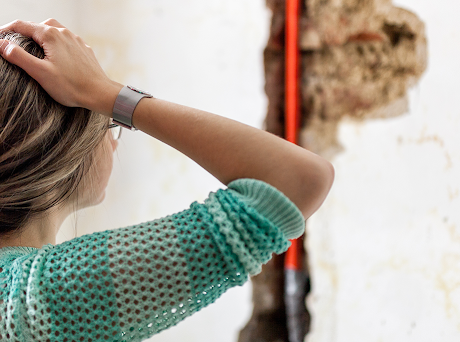A small water leak can add up to a big deal. According to the Environmental Protection Agency, the average household leak can account for almost 10,000 gallons of water waste each year.
Wasted water is bad news for your home, the environment, and, of course, your wallet. Keep reading to learn where common household water leaks occur around your home, how to stop them in their tracks and how to prevent future leaks from occurring.
Common Causes of Water Leaks
Toilet Leaks
Your toilets are frequently used appliances. Over time, all of that usage can lead to wear and tear and cause water leaks.
Some of the most common causes of a toilet leak include a broken flush valve, a worn-out flapper, worn-out and broken seals, rusted pipes and cracks. The first three are relatively easy do-it-yourself fixes, with most of the parts available at your local hardware store. A small hairline crack on the outside of the toilet bowl can often be patched up; however, large cracks or cracks inside the bowl mean you must replace the toilet. Rusted or corroded pipes will also need to be inspected/repaired by a professional unless you’re an advanced DIY’er.
A leaking toilet can waste as much as 200 gallons of water per day and 6,000 gallons a month, causing your water bill to increase by more than $30.
Shower Leaks
Shower leaks can also lead to significant water waste. According to the EPA, a showerhead that drips 10 times per minute can waste as much as 500 gallons of water per year, or the equivalent of running the dishwasher 60 times.
You can attempt a DIY fix on a leaky showerhead by replacing the faucet cartridges or washers. For larger or more complicated leaks, contact a licensed plumber to inspect the showerhead and your bathroom plumbing system.
Faucet Leaks
Faucet leaks aren’t only annoying and can keep you up at night, but they are also huge water wasters. A drip rate of once every two seconds can account for a loss of 1,500 gallons of water per year. Similar to a shower leak, most DIY’ers can attempt to fix this issue by turning off the water at the shutoff valve and replacing the faucet cartridges or washers.
Whole-house Humidifier Leaks
If your whole-house humidifier’s drain line is clogged, water can build up in the unit and cause leaks, leading to a sharp increase in your water bill. Clogged lines can create serious issues and lead to expensive water bills. If your humidifier is leaking, you’ll often notice water around your forced-air HVAC system.
Water Heater Leaks
Traditional tank water heaters last about eight to 12 years on average. When units reach their life expectancy, the tank can become rusted and corroded leading to water leaks. It’s a good idea to replace an older water heater that is leaking water to avoid serious water damage.
Washing Machine Leaks
Like other water-using appliances, your home’s washing machine can develop leaks over time due to wear and tear. The most common reason for a washing machine leak is corroded or weakened hoses which lead from the spigots to the washing machine. Cracks, bubbles or discoloration can indicate damage to the hose, and it should be replaced right away.
Water Supply Line Leaks
Your home’s water supply pipes transport water from your well or utility water main into your home. Because these water pipes are buried underground, it’s hard to tell if there’s a leak. Some common signs to watch for that indicate a water supply line leak include sinkholes, wet spots in your yard, cracked pavement, foundation cracks, an annual increase in water usage, and a drop in water pressure.
Damaged Pipe Joints
Pipe joints are connections at the end of pipes and ensure two pieces of pipes can connect. If the pipes are not properly connected to the joint, it can cause leaks that can lead to damage and higher water bills.
Maintaining the Highest Standards of Water Quality
Indiana American Water cares about our customers and wants to help them conserve water to save money while protecting the environment. If you have a household water leak, be sure to contact a plumber as soon as possible to investigate and repair the issue.
As a company, we are proactive about making investments that are needed without delay. Click here to learn more about our recent initiatives and what we are doing to improve the quality of your water every day.



